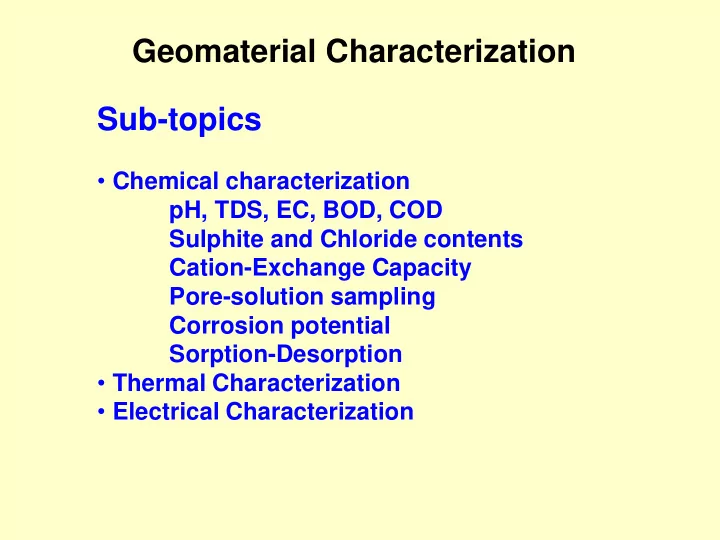

Geomaterial Characterization Sub-topics • Chemical characterization pH, TDS, EC, BOD, COD Sulphite and Chloride contents Cation-Exchange Capacity Pore-solution sampling Corrosion potential Sorption-Desorption • Thermal Characterization • Electrical Characterization
pH determination Glass calomel electrode is used Soil solutions with different Liquid to solid ratios pH Temperature Total Dissolved Solids Electrical Conductivity Chemical Oxygen demand Biological Oxygen Demand
Chloride and Sulphite contents determination The chloride and sulphite contents of the soils can be obtained on an extract of 2:1 Liquid to solid ratio. Indion Easy test kit (Ion Exchange, India Ltd.), an ion exchange resin, is employed A sort of a titration Change in color of the solution due to addition of chemicals
Pore-solution Sampling The pore-solution sampling is identical to blood sampling A Prerequisite to Soil-Water-Contaminant Interaction Studies To predict transport/fate of contaminants in the soil mass Design of suitable containment/Barrier system Assessment of safe waste disposal limits: Quantity & Concentration Leaching/Attenuation characteristics of soils Intrusion of pollutants in ground water resources Prediction of the loss of nutrients from the root zone Detection of the microbial activity in soils Validation of solute transport models
Sampling Techniques In-situ (Field) • Lysimeter Zero-tension Lysimeter Tension Lysimeter • Soil Salinity Sensors • Absorption Techniques Laboratory • Centrifugation • Pressure-membrane extractor (PME)
In-situ studies Objective: To simulate disposal facility in a Control Volume based on moisture movement concentration of contaminant(s) Using a Lysimeter A device which collects and senses percolating water through soil mass and helps in determining the Concentration of water soluble contaminant(s) As a function of time and space
Lysimeter Studies Simulate the effect of percolating rainfall on the release of contaminants from waste froms Provide insight in understanding the site as well as validating water balance studies and radionuclide migration in the unsaturated zone Data obtained from the study provide a link between the laboratory and field conditions and thus aid in predicting radionuclide migration from shallow land disposal facility
Lysimeter ( Pore Solution Collection Device) Zero Tension Lysimeter Collects Pore Solution From Saturated Soils Percolating water Control volume Soil Pervious fill Collection device to Collection bottle
Field Lysimeter To collect leachate 485 mm Percolating water Waste rock material 40 mm thick creek sand 50 mm thick Gravel (5-7 mm) 300 mm thick Gravel (14mm) Gravel (5-7 mm) Occurrence of preferential flow Influence of mobile colloids on contaminant mobility Extra organic matter in soil reduced colloid release
Zero-tension Lysimeter Loose fill O A Undisturbed soil core Sand Sloping bottom A : Air inlet O : Pore solution extraction
Collection Basin Lysimeter Clay liner Granular Backfill P Flexible membrane liner P : Perforated pipe To detect leakage from the clay liner To determine in situ hydraulic conductivity of the liners To demonstrate proper functioning of the clay liner
Basic Philosophy Rain water Upper compartment with fill material, sensors and moisture extraction cups Lower compartment for leachate collection Leachate Performance assessment of solidified radioactive waste Attenuation properties of soils Validation of theoretical model by fitting Mathematical model to Lysimeter data
Tension Lysimeter Collects pore- solution from “Unsaturated Soils” To sample bottle To Vacuum pump Ground PVC pipe I – Inflow of pore solution Porous ceramic cup under vacuum applied I I
Very preliminary design To vacuum pump and collection bottle Ground surface Soil A Soil A – Porous plate B – Leachate collecting bottle B
Soil Salinity Sensors Used for in situ measurement of soil salinity Soil salinity is an indication of soil contamination Absorption techniques Sponge material as absorbent for sampling pore solution • Large surface area of the sponge improves sampling efficiency • Not a fully harnessed method
Recommend
More recommend